

Museum 2.0: The Art of Relevance Sneak Peek: Whose Room is This? This month, I'm sharing a few chapters from my new book The Art of Relevance to celebrate its release.
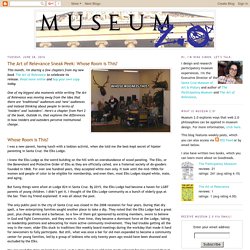
Read more online and buy your own copy today.One of my biggest aha moments while writing The Art of Relevance was moving away from the idea that there are "traditional" audiences and "new" audiences and instead thinking about people in terms of "insiders" and "outsiders". Here's a chapter from Part 2 of the book, Outside In, that explores the differences in how insiders and outsiders perceive institutional change. Whose Room is This? I was a new parent, having lunch with a lesbian activist, when she told me the best-kept secret of hipster parenting in Santa Cruz: the Elks Lodge. I knew the Elks Lodge as the weird building on the hill with an overabundance of wood paneling. But funny things were afoot at Lodge 824 in Santa Cruz.
The only public pool in the city of Santa Cruz was closed in the 2008 recession for four years. You can read this story at least two ways. Making Museums Welcoming to All Families - Bay Windows. May is National Museum Month, and LGBTQ families have a growing source of support in museums—including ones aimed at children—that have been reaching out to welcome all kinds of families.

Margaret Middleton, a Boston-based designer, speaker, and consultant, has been a leader in helping to make this happen. Middleton, who has spoken at numerous museum conferences and been profiled on NPR, has been doing museum work for about ten years and family inclusion work for half of that. She told me in an e-mail interview that the latter “began as a melding of my queer activism with my museum practice. But I quickly realized that it wasn't just queer families who were being left out in museums: single parents, adoptive families, foster families, and families with divorced parents weren't taken into consideration.” And in 2012, she worked with curator Lisa Ellsworth at the Children’s Discovery Museum of San Jose on an exhibit inspired by San Jose Pride. Museum 2.0: The Art of Relevance Sneak Peek: What IS Relevance? This month, I'm sharing a few chapters from my new book The Art of Relevance in advance of its release.
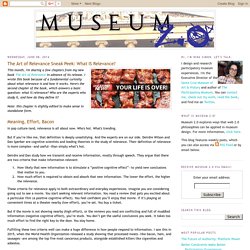
I wrote this book because of a fundamental curiosity about what relevance is and how it works. Here's the second chapter of the book, which answers a basic question: what IS relevance? Who are the experts who study it, and how do they define it? Note: this chapter is slightly edited to make sense in standalone form. Our Museum - Communities and museums as active partners.
Our City, Our Stories - Museum of Liverpool, Liverpool museums. Community displays in the Museum of Liverpool Our City, Our Storiesis the Museum of Liverpool's ongoing partnership programme.
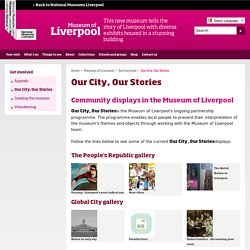
The programme enables local people to present their interpretation of the museum's themes and objects through working with the Museum of Liverpool team. Follow the links below to see some of the current Our City, Our Storiesdisplays. The People's Republic gallery Global City gallery Wondrous Place gallery Fans - red, white and blue20 stories highLita Roza History Detectives Get involved. Why Storytelling May Be the Next Big Thing in Museum Funding - Inside Philanthropy: Fundraising Intelligence - Inside Philanthropy. The San Francisco Museum of the African Diaspora (MoAD) received a multi-year grant from the James Irvine Foundation's Exploring Engagement Fund to support a two-year storytelling project entitled "Crossing Fences: Conversations and Stories with African-American Men Across the Generations," underscoring how museums can capitalize on the growing popularity of storytelling to engage new audiences.

You may have noticed the renaissance of the "art" of storytelling in the last half-decade. Thanks to social media, YouTube, and digital production technology, everyone can be a storyteller. Sustainability Toolkits. Amazing Neighbourhoods: Engagement and Sustainability Planning Guide (National Version) This updated guide is meant for anyone seeking to engage and collaborate with their neighbours and neighbourhood stakeholders to make their neighbourhood an amazing place to live, work, and play.
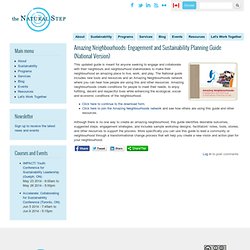
The National guide includes new tools and resources and an Amazing Neighbourhoods network where you can hear how people are using this and other resources. Amazing neighbourhoods create conditions for people to meet their needs, to enjoy fulfilling, decent and respectful lives while enhancing the ecological, social and economic conditions of the neighbourhood. Although there is no one way to create an amazing neighbourhood, this guide identifies desirable outcomes, suggested steps, engagement strategies, and includes sample workshop designs, facilitators’ notes, tools, stories, and other resources to support the process.
Engage: Museums and Communities. Strengthening Immigrant Voices through Museum-Community College Partnerships. According to the report Adult ESL and the Community College, “ESL [English as a Second Language] is one of the fastest growing areas of need in the community college,” with immigrants (many of whom are not fluent in English) constituting up to 25 percent of community college students—a share that is expected to increase in the coming years (Crandall and Sheppard 2004, 5).
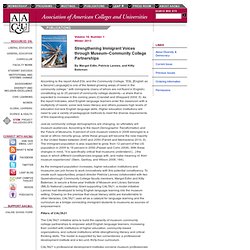
As the report indicates, adult English language learners enter the classroom with a multiplicity of needs: some lack basic literacy and others possess high levels of education but lack English language skills. Higher education institutions will need to use a variety of pedagogical methods to meet the diverse requirements of this expanding population. Just as community college demographics are changing, so ultimately will museum audiences.
As the immigrant population increases, higher education institutions and museums can join forces to work innovatively with this potential constituency. Pillars of CALTA21 References.